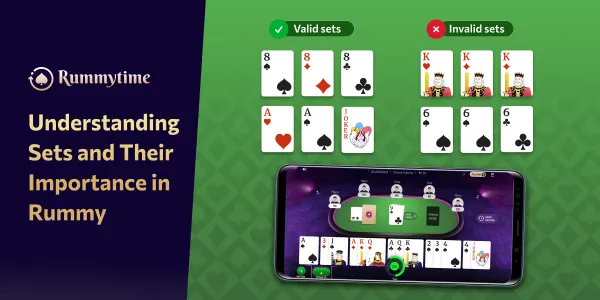- Home
- Rummy Sphere
- How to play Gin rummy: a beginner’s guide
How to play Gin rummy: a beginner’s guide
Gin rummy is a fast-paced rummy game usually played between two players. This exciting variant of rummy requires a mix of skill and strategy.
RummyTime Elite Editors | 15th Jul, 2025

Learn how to play Gin rummy
Gin rummy is a fast-paced rummy game usually played between two players. This exciting variant of rummy requires a mix of skill and strategy. It was started somewhere around the early 1900s and was developed with traditional rummy as a base. What makes Gin rummy different is its quicker gameplay and simpler scoring system. Unlike other rummy variants, Gin rummy focusses on forming sets (three or four of a kind) and sequences (consecutive cards of the same suit) to reach a target score. And instead of a declaration, players say “knock” in Gin rummy when the points of their unmatched cards is less than 10.
Basics of Gin rummy
Unlike traditional rummy which can be played with up to 6 players, Gin rummy can only be played with 2 players, using a standard deck of 52 cards. The aim in this variant of the rummy is to form valid sets and sequences.
Each player gets 10 cards at the start of the game, the remaining cards are kept in a pile known as the draw pile. The top card from the draw pile is kept face up and it is considered as the first card of the discard pile. During their turn, each player discards a card after drawing one of either the discard pile or draw pile. Gin rummy requires players to have a good memory and remember the discarded cards of their opponents.
Gin rummy gameplay
At the start of each game, the dealer gives 10 cards to each player, placing the remaining deck face-down as the draw pile. Players take turns drawing either from the draw or discard pile and discarding one card each turn. To score, players must form valid sets and sequences while minimising deadwood i.e. points of unmatched cards.
To finish a game, a player can “knock” when their deadwood is 10 points or fewer, ending the round. If a player achieves zero deadwood (all cards are arranged in sets and sequences), it is known as “Gin”, this results in the player getting extra points. The opponent can lay off cards on the knocker’s melds before the final score is calculated. The game continues until a player reaches a pre-decided score.
Dealing the cards
Gin rummy is played with two players and a standard 52-card deck. One player is chosen as the dealer, who shuffles and deals 10 cards to each player. The remaining deck forms the draw pile, and the top card is placed face-up to start the discard pile.
A dealer can be chosen by dealing one card each to a player and the one with the highest card, becomes the dealer for the first round.
Drawing and discarding
On their turn, a player must discard one card after drawing a card either from the discard pile or closed (draw) pile. The objective is to form valid sets and sequences while minimizing deadwood.
Forming sets and sequences
- A set consists of three or four cards of the same rank (e.g., 7♠ 7♦️7♣).
- A run consists of three or more consecutive cards of the same suit (e.g., 4♠ 5♠ 6♠).
Knocking and going Gin
A player can knock when their deadwood is 10 points or fewer. Knocking ends the round, and players compare deadwood values to determine the winner. If a player has no deadwood, they declare Gin and receive a bonus.
Basic scoring principles
The winner of a round earns points based on the opponent’s deadwood total. Additional bonuses are given for Gin and for undercutting an opponent’s knock.
Deadwood points calculation
Each card has a point value:
- Aces = 1 point
- Face cards (K, Q, J) = 10 points
- Number cards = Face value (e.g., 7 = 7 points)
At the end of a round, the knocker’s and opponent’s deadwood totals are compared, and the difference is awarded as points.
Knocking and undercut scoring
- A player knocks when their deadwood is 10 or fewer.
- If the opponent has an equal or lower deadwood total, they score an undercut bonus.
- The difference in deadwood scores determines how many points the winner receives.
Gin bonus and game-winning score
- A player who declares Gin (no deadwood) earns a Gin bonus.
- The game continues until a player reaches a pre-decided target score, typically 100 points.
Observing your opponent’s moves
- Pay attention to which cards they pick and discard.
- Avoid discarding cards they might need for their sets or runs.
- Predict their potential melds based on their moves.
Managing your hand efficiently
- Keep versatile cards that fit multiple sets or runs.
- Prioritize forming complete sets and sequences.
- Reduce deadwood to prepare for an early knock.
The right time to knock
- Knock early if you have low deadwood to reduce your opponent’s chances of improving their hand.
- Go for Gin if you have a strong hand, maximizing points.
- Avoid knocking too late, as the opponent may already have a better deadwood score.
Common mistakes to avoid
- Drawing to an inside straight – Holding out for a specific middle card (e.g., 5-? -7) limits flexibility.
- Not tracking an opponent’s moves – Ignoring their discards and draws can help them win.
- Knocking too late – Waiting too long might give the opponent time to undercut or declare Gin.
By mastering these strategies and avoiding common mistakes, you can enhance your Gin rummy skills and increase your chances of winning.
RummyTime app doesn’t offer Gin Rummy, but you can still play Pool, Points and Deals rummy. Download the app and start playing today.
Featured articles







